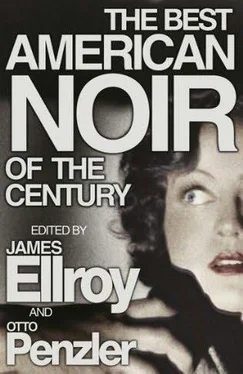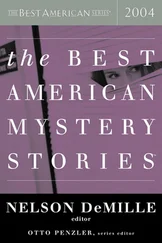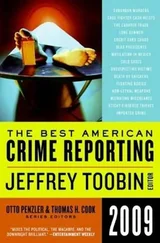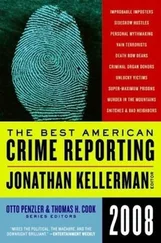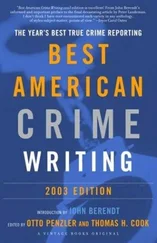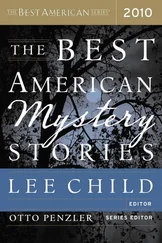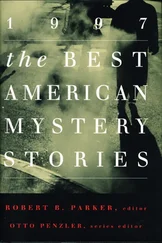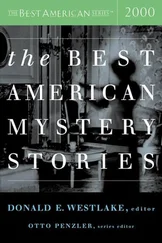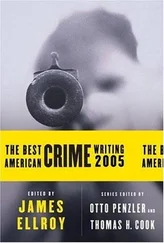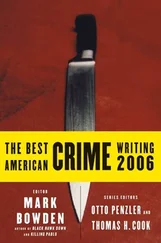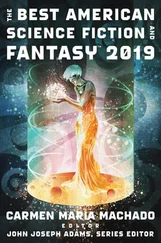Nelly broke all six chalks in six steady shots, and Miss Antoinette McReady kissed him, and Frank Wanda had to get a new fellow for the pool hall when Nelly left town with the show after the last performance on Saturday night.
It was six months later when I heard my father exclaim, while he was taking press dispatches over the out-of-town wire. He often did that when some news came through which particularly interested or excited him. I left my desk and went to look over his shoulder, while his fat old fingers pushed out the story on the typewriter.
* * *
hampton, Colorado, April 2. — Two desperate trick-shot artists gave Hampton residents an unscheduled exhibition today. When the smoke had cleared away the Hampton County Savings Bank discovered it had paid more than $7,000 to watch the show.
Shortly after the bank opened this morning, a young man and a young woman, identified by witnesses as “Cowboy” Nelson Tare and Miss Antoinette McReady, walked into the bank and commanded tellers and customers to lie down on the floor. They scooped up $7,150 in small bills, and were backing toward an exit, when Vice-President O. E. Simms tried to reach for a telephone.
The trick-shot bandits promptly shot the telephone off the desk. They pulverized chandeliers, interior glass, and window lights in a rapid fusillade which covered their retreat to their car.
Within a few minutes a posse was in hot pursuit, but lost the trail near Elwin, ten miles south of this place. A stolen car, identified as the one used by the bandits, was found abandoned this noon near Hastings City. State and county officers immediately spread a dragnet on surrounding highways.
Nelson Tare and his female companion were easily recognized as stunt shooters with a traveling carnival which became stranded in El-win a week ago. A full description of the hard-shooting pair has been broadcast to officials of five nearby states.
* * *
All the time I was reading it, I kept thinking of Nelly Tare, half-pint size in a dirty red coat, asking me, “Dot any duns?”
They were captured in Oklahoma that summer, after another robbery. Antoinette McReady, whose real name turned out to be Ruth Riley, was sent to a women’s penal institution; Nelly Tare went to McAlester Prison. He managed his escape during the winter two years later, and started off on a long series of holdups which carried him south into Texas, over to Arkansas, and north into Missouri.
Those were the days of frequent and daring bank robberies throughout that region. There were a lot of other bad boys around, and Nelly was only one of the herd. Still, he began to appear in the news dispatches with increasing regularity, and when some enterprising reporter called him Nice Nelly, the name stuck and spread. It was a good news name, like Baby Face or Pretty Boy.
They recaptured him in Sedalia; the story of his escape from the Jefferson City Penitentiary in 1933 was front-page stuff all over the nation. It was always the same — he was always just as hard to catch up with. He was always just as able to puncture the tires of pursuing cars, to blast the headlights that tried to pick him out through the midnight dust.
Federal men didn’t enter the picture until the next January, when Nelly kidnapped a bank cashier in Hiawatha, Kansas, and carried him nearly to Lincoln, Nebraska. That little state line made all the difference in the world. The so-called Lindbergh Law had come into existence, and Nice Nelly Tare became a public enemy on an elaborate scale.
It is not astonishing that some people of Elm City basked in this reflected notoriety.
Reporters from big-city papers, photographers from national magazines, came poking around all the time. They interviewed Nelly’s sister, poor Mrs. Ira Flagler, until she was black in the face — until she was afraid to let her children play in the yard.
They took pictures of Frank Wanda’s pool hall, and they would have taken pictures of Frank if he hadn’t been dead. They managed to shake Miss Cora Petersen, late of Elm City’s eighth grade, from asthmatic retirement. Her homely double-chinned face appeared in a fine-screen cut, in ugly halftones — a million different impressions of it. read teacher’s story of how nice nelly, baby bandit, drew his first bead on her. other pictures on page seven.
Clyde Boston and I used to talk about it, over in Clyde’s office in the courthouse. Clyde Boston had been sheriff for two terms; he was just as apple-cheeked and good-natured as ever, though most of his hair was gone. He would shake his head when we talked about Nelly Tare, which we did often.
“You know,” he’d say, “a lot of people probably doubt those stories about Nelly’s fancy shooting — people who haven’t seen him shoot. But I still remember that time he had you throw a snowball for him to break with a rifle. He certainly is gun crazy.”
* * *
It was during the late summer of 1934 — the bad drought year — when Nelly held up a bank at Northfield, Minnesota, and was promptly dubbed the Modern Jesse James.
Officers picked up Nelly’s trail in Sioux Falls, and that was a relief to us in Elm City, because people had always feared that Nelly might be struck with a desire to revisit his boyhood haunts and stage a little shooting right there in the lobby of the Farmers’ National Bank. Nelly’s trail was lost again, and for two weeks he slid out of the news.
Then came the big story. Federal men very nearly recaptured him in Council Bluffs, though he got away from them even there. Then silence again.
About two o’clock of the following Thursday afternoon, I went up to the courthouse on printing business. I had stopped in at Sheriff Clyde Boston’s office and was chewing the rag with Clyde, when his telephone rang.
Clyde picked up the phone. He said, “Yes …Yes, Barney …He did? …Yes …Glad you called me.” He hung up the receiver and sat drumming his fingers against a desk blotter.
“Funny thing,” he said. “That was young Barney Meisner, down at the hardware store.”
“What did he have to say?”
“He said that one of the Flagler kids was in there a while ago and bought two boxes of forty-five shells. Funny, isn’t it?”
We looked at each other. “Maybe Ira Flagler’s decided to emulate his wife’s folks,” I said, “and take up trick shooting on the side.”
Clyde Boston squeezed out a smile. “Guess I’ll ride up to their house and ask about it.”
So I went along with him, and when we got to the green-and-white Flagler house on West Water Street, we saw a coupe parked in the drive. Clyde breathed rapidly for a moment; I saw his hands tighten on the steering wheel, until he could read the license number of the car. Clyde relaxed. It was a Vera Cruz County number; it was one of our own local cars; I remembered that I had seen Ira Flagler driving that car sometimes.
Clyde parked across the street, although down a little way. He got out on the driver’s side and I got out on the other side. When I walked around the rear of the car and looked up at the Flagler house, Nelly Tare was standing on the porch with a revolver in his hand.
I guess neither Clyde nor I could have said anything if we had been paid. Clyde didn’t have his own gun on; sheriffs didn’t habitually carry guns in our county anymore. There was Nelly on the porch, covering us and looking just about the same as ever, except that his shoulders had sagged and his chin seemed to have receded a good deal more.
He said, “Lay down on the ground. That’s right — both of you. Lay down. That’s right — keep your hands up.”
When we were on the ground, or rather on the asphalt pavement which formed the last block of Water Street, Nelly fired four shots. He put them all into the hood and engine of the car, and then we heard his feet running on the ground. I didn’t look for a minute, but Clyde had more nerve than I, and got up on his haunches immediately.
Читать дальше
Конец ознакомительного отрывка
Купить книгу
